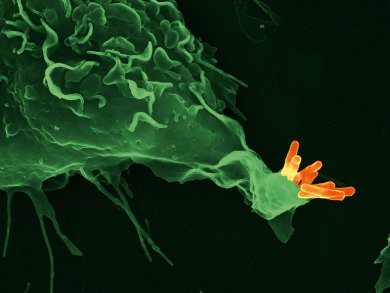Around two billion people throughout the world carry the pathogenic bacterium Mycobacterium tuberculosis — only one tenth of them actually develop tuberculosis (TB). Predicting who will fall ill is impossible. Researchers from the Max Planck Institute for Infection Biology in Berlin, Germany, have discovered several candidates for biomarkers that indicate a person’s susceptibility to TB. They compared the gene activity in tuberculosis patients and in individuals latently infected. They found 1935 genes in tuberculosis patients that differed in activity from those of latently infected patients, with the greatest difference between two groups in the Fc gamma receptor which is located on the surface of immune cells.
By using this and four other biomarkers, the researchers were able to diagnose tuberculosis patients with 94 % certainty and latently infected healthy subjects with 97 % certainty.
Image: © Max Planck Institute for Infection Biology/Volker Brinkmann
- Human gene expression profiles of susceptibility and resistance in tuberculosis
J. Maertzdorf, D. Repsilber, S. K. Parida, K. Stanley, T. Roberts, G. Black, G. Walzl, S. H. E. Kaufmann,
Genes and Immunity 2011, 12, 15–22.
DOI: 10.1038/gene.2010.51
► Also see:
- News: World TB Day 2011: March 24
World tuberculosis (TB) day commemorates the day the pathogenic bacteria that causes TB was discovered - News: A Drug Pipeline Going Dry
The number of effective anti-tuberculosis (TB) drugs continues to dwindle; can we find new agents for treating drug-resistant TB? - News: Rare and Neglected Diseases
With diseases such as malaria being classed as rare and neglected, ChemMedChem takes a look at the latest research in this field - News: Protein for New TB Vaccine
Protein secreted by tuberculosis bacteria is a promising candidate for a new vaccine




